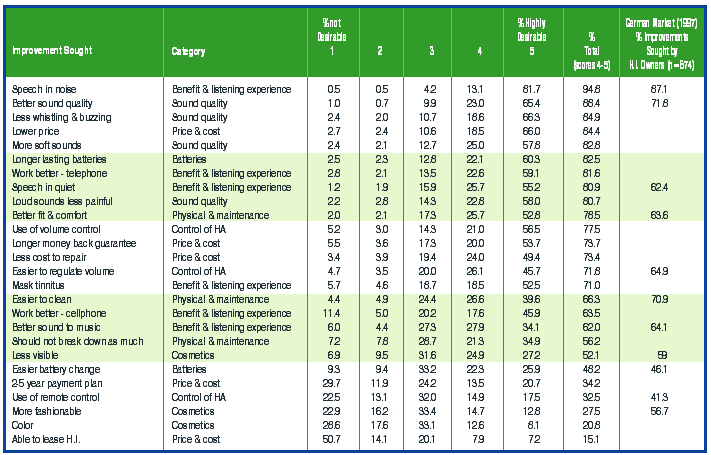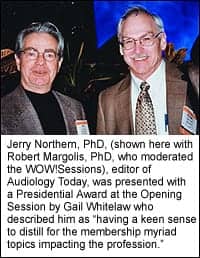This is the third installment of a multi-part series covering significant trends in the hearing instrument market. The first installment1 covered detailed 17-year demographic trends in the US hearing instrument market, while the second installment2 explored 10-year customer satisfaction trends. The purpose of this third paper is to investigate improvements in hearing instruments most sought after by current hearing instrument owners.
In previous Knowles MarkeTrak publications, the implicit belief was that hearing instrument factors with lower satisfaction scores deserved the most attention if we were to positively impact the consumer’s experience with their hearing instruments. In a previous MarkeTrak study, four key factors emerged as the strongest determinants of overall customer satisfaction improvement: 3
- Improved benefit/value
- Better sound quality
- Better reliability
- Multiple Environmental Listening Utility (MELU)
In fact, these four factors were shown to explain 96% of the variance in overall satisfaction. In terms of establishing a strategy for enhancing the consumer’s experience with hearing instruments, it would seem that the most likely candidates for customer satisfaction improvement are: 1) those factors with the lowest ratings, and 2) those factors that are highly correlated with overall satisfaction.
While MarkeTrak has been reporting on customer satisfaction with hearing instruments for 10 years, we never explicitly asked customers what improvements they want in their hearing instruments. In this publication, we specifically ask consumers the improvements most important to them.
Method
For the detailed methodology of this study, the reader is referred to the first publication in this series.1 After an initial screening survey using the National Family Opinion panel in January 2001, an extensive customer satisfaction survey was sent to 3,000 hearing instrument owners with tabulation of the data occurring in April 2001. The response rate for the hearing instrument owner survey was 87%. Using the methodology of Armin Stock and colleagues5 in a study of the German hearing instrument market (that presented consumers with 11 factors relative to customer satisfaction), hearing instrument owners in the US were presented with a list of 26 possible improvements in hearing instruments and asked to rate each item on a 5-point scale (5=highly desirable, 1=not desirable).

Results and Discussion
Table 1 presents the detailed ratings of improvements sought by consumers in rank order. The results are presented by improvement category in Figures 1-6. Scores of “5” (highly desirable) are the darker shade, while scores of “4” are the lighter shade. Wherever possible, I will compare and contrast consumer “improvement” scores with consumer satisfaction scores. Detailed consumer satisfaction data are documented in the previous publication2 and will not be presented again here.
Figure 1. Benefit and listening improvements sought in hearing
instruments by current owners. The dark blue bar represents
consumers who rated the factor as “highly desirable” (a score
of “5” on the survey), while the lighter blue bar represents those
ratings of “desirable” (a score of “4” on the MarkeTrak VI survey).
Benefit and Listening Experiences (Figure 1): The number-one improvement sought in hearing instruments in both the US and German markets is speech intelligibility in noise. Nearly 95% of current hearing instrument owners indicate this is a highly desirable improvement, compared to 87% in the German market. The US sample of users report only a 29% satisfaction with their hearing instruments in noisy situations. This is the third lowest customer satisfaction rating, slightly ahead of cell phone usage satisfaction (24%) and performance in large group situations (25%).
More than eight out of 10 consumers welcome improved hearing instrument performance in understanding speech in quiet and on the telephone. This should be contrasted with an 86% customer satisfaction rating on one-on-one communication and 38% on the telephone. Seven out of 10 consumers would also like their hearing instruments to function as a tinnitus blocker. Slightly more than six out of 10 consumers would like to see improved cell phone usage (customer satisfaction rating = 24%) and would like music to sound better (customer satisfaction rating = 69%).
Figure 2. Sound quality improvements sought in hearing
instruments by current owners.
Sound Quality (Figure 2): The second most desired improvement in hearing instruments in both the US and German markets is “better sound quality.” Slightly less than nine in 10 US consumers (88%) rated sound quality improvement as highly desirable compared to 72% in the German market. This factor is a complicated one because sound quality is so subjective and is composed of so many dimensions. In Figure 2, slightly more than eight out of 10 consumers rated less whistling and buzzing (third highest rating in terms of desired improvement), more soft sounds audible, and loud sounds less painful as desirable improvements. The customer satisfaction ratings for these factors are 37%, 46%, and 39, respectively. Additional “sound quality” customer satisfaction ratings are as follows: clearness of tone and sound (55%), natural sounding (52%), and sound of voice (54%).
Figure 3. Comfort and maintenance improvements sought in
hearing instruments by current owners.
Fit, Comfort, and Maintenance (Figure 3): Nearly eight out of 10 (79%) US consumers asked for hearing instruments with better fit and comfort despite a relatively high customer satisfaction rating of 77%. In comparison, 64% of German consumers rated “better earmolds” as a desired improvement. Slightly less than seven out of 10 (66%) consumers asked for hearing instruments that were easier to clean (customer satisfaction rating = 57% for frequency of cleaning), while 56% indicated that hearing instruments “should not break down as much” (customer satisfaction rating = 69% for hearing instrument reliability). By comparison 71% of the German consumers rated ease of cleaning as a desirable improvement.
Figure 4. Price and cost improvements sought in hearing
instruments by current owners.
Price and Cost (Figure 4): Approximately 85% of consumers believe hearing instruments should be priced lower (customer satisfaction = 52% for value). Lower priced hearing instruments are fourth on the list in terms of desired improvements. In research on more than 25,000 consumers, I have yet to find a meaningful correlation between price paid for the hearing instrument and overall satisfaction. Due to the complex relationships involved, an entire publication will be devoted to the role of price in achieving higher levels of customer satisfaction.
Nearly three in four would like a longer money back guarantee and hearing instruments that are less costly to repair (customer satisfaction = 45% for on-going expense). Hearing instrument consumers are less likely to be interested in longer payment plans (eg, 2-5 years) for hearing instruments (34%) and in leasing hearing instruments (15%). Consumers whose hearing instrument is older than 6 years (and ready for replacement) are more interested in longer payment terms and leasing.
Figure 5. Cosmetic improvements sought in hearing instruments
by current owners.
Cosmetics (Figure 5): The average hearing instrument owner does not consider cosmetics as high a priority for improvement as the previously disussed performance issues (hearing in noise, sound quality). Slightly more than half of US consumers would like hearing instruments that are less visible compared to 59% in the German market (US customer satisfaction = 63% for visibility). Only one in five are interested in improvements in hearing instrument color, and about the same number indicate that more fashionable hearing instruments are desirable. In comparison, 57% of German hearing instrument owners indicated that more fashionable hearing instruments were desirable.
Figure 6. Batteries and hearing instrument control improvements
sought in hearing instruments by current owners.
Batteries and Hearing instrument Control (Figure 6): More than eight out of 10 (83%) US consumers requested batteries that lasted longer, and slightly less than half (48%) requested hearing instruments that feature easier-to-change batteries (compared to 46% in the German market).
More than three-quarters of US consumers indicate they want the use of a volume control on their hearing instrument, while seven out of 10 report they want hearing instruments that feature easier regulation of the volume; however, only 32% are interested in a remote control. In the German market, 65% report the desire to have a method for easier regulation of the volume, and 41% indicate interest in a remote control for their hearing instrument.
In a previous publication,2 it was shown that customer satisfaction with ease of control of volume has declined 11% points since 1991 as more and more automatic hearing instruments are sold into the market. About one-third of owners lacking a volume control indicate they want one. The lack of a VC would appear to have more of a negative impact on experienced users, who are used to a volume control, and less so on new users.
Conclusions
The MarkeTrak series has looked at customer satisfaction using four methodologies:
- Customer satisfaction ratings (% satisfied, dissatisfied)2
- Correlates of overall satisfaction (a form of importance measure)3
- Improvements sought by consumers in their hearing instruments (this article)
- Why hearing instruments are in the drawer4
I believe it is useful to summarize the top issues under each method:
- Factors with customer satisfactioscores below 40%:
- Hearing in noise
- Hearing instrument usage in large groups
- Hearing instrument usage on telephones and cell phones
- Hearing instrument usage at concerts and movies
- Whistling, feedback and buzzing
- Comfort with loud sounds
- Factors most related to customer satisfaction improvement:
- Improved benefit/value
- Better sound quality
- Better reliability
- Multiple Environmental Listening Utility (MELU)
- Reasons why hearing instruments are in the drawer (in rank order):
- Poor benefit
- Inability to hear in noise/background noise
- Poor fit and comfort
- Negative side effect of hearing instrument
- Price & cost of repairs
- Improvements sought in hearing instruments (this article):
- Speech intelligibility in noise
- Better sound quality
- Less whistling and buzzing (feedback)
- Lower price
- More soft sounds audible
After 10 years of measuring customer satisfaction, we now have a clear picture of the hierarchy of consumer needs as it pertains to hearing instruments. We know what needs to be done to improve customer satisfaction. Without significant improvements for millions of consumers in these core areas, it is unlikely that our industry can experience market growth exceeding the growth rate of the elderly population (2%-3% per year).
For the custom hearing instrument industry to move forward, the hearing industry and hearing care professionals need to find ways to improve the consumer’s experience with hearing instruments and, therefore, improve their quality of life. When this is accomplished positive-word-of mouth advertising will increase and market growth will be guaranteed.
The top issues are: performance in noise, sound quality, multiple environmental listening utility (that is the ability to delight or provide benefit to the consumer in as many listening situations as possible), reliability in the product, servicing the devices as promised, hearing instruments which are comfortable and fit well, and hearing instruments which are perceived as a good value by the consumer.
In his 1997 perspective on the hearing instrument market, Andreas Rihs wrote:
What does it take to turn the hearing instrument market around?
- The underdeveloped hearing instrument market can only reach its potential if the hearing instrument becomes a true personal communication device.
- The stigma of hearing instruments will decrease parallel to the increase in hearing performance.
- The degree of user satisfaction is directly related to hearing performance and not the cosmetics.
- The negative image of the hearing instrument will only disappear when hearing comfort and communication in all environments are guaranteed.6
These insights are as true today as they were 5 years ago.

|
Correspondence can be addressed to HR or Sergei Kochkin, PhD, Knowles Electronics, 1151 Maplewood Dr., Itasca, IL 60143; email: [email protected].
References
1. Kochkin S. MarkeTrak VI: The VA and direct mail sales spark growth in hearing instrument market. Hearing Review. 2001;8(12):16-24, 63-65.
2. Kochkin S. MarkeTrak VI: Ten year customer satisfaction trends in the US hearing instrument market. Hearing Review. 2002;9(10):14-25,46..
3. Kochkin S. MarkeTrak III identifies key factors in determining customer satisfaction. Hearing Jour. 1993;46(8):39-44.
4. Kochkin S. MarkeTrak V: Why my hearing aids are in the drawer: the consumer’s perspective. Hearing Jour. 2000;53(2):34-42.
5. Stock A, Fichtl E, Heller O. Comparing determinants of hearing instrument satisfaction in Germany and the United States. In: Kochkin S, Strom K, eds. High Performance Hearing Solutions, Vol. 2. Hearing Review. 1997;4(11)(suppl, Vol 2):40-46.
6. Rihs A. Perspective: Is the hearing industry on the right track? In: Kochkin S, Strom K, eds. High Performance Hearing Solutions, Vol. 2. Hearing Review 1997; 4(11)(suppl, Vol 2): 47-49.


%20nov02.jpg)
%20nov02.jpg)
%20nov02.jpg)
%20nov02.jpg)
%20nov02.jpg)
%20nov02.jpg)


